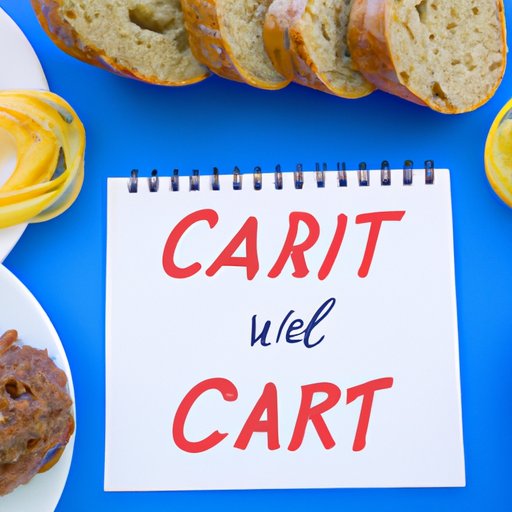Introduction
A carbohydrate diet is a type of eating plan that focuses on limiting carbohydrates while emphasizing other types of food. This type of diet is often used for weight loss, as well as to improve overall health and well-being. In this article, we will explore the basics of a carbohydrate diet, its potential health benefits and risks, how to create an effective meal plan, popular low-carb diets, foods to eat and avoid, tips for sticking to the diet, and more.
Exploring the Basics of a Carbohydrate Diet
Carbohydrates are one of the three major macronutrients, along with proteins and fats. They are found in a variety of foods, including grains, starchy vegetables, fruits, and dairy products. Carbs provide energy for the body and are the main source of fuel for the brain, heart, and muscles. They also play a role in digestion, metabolism, and other bodily functions.
Carbohydrates are broken down into two categories: simple and complex. Simple carbs are found in processed and refined foods such as white bread, candy, and soda. Complex carbs are found in whole foods such as fruits, vegetables, legumes, and whole grains. They contain more fiber and nutrients than simple carbs, which makes them a healthier choice.
When you eat carbohydrates, they are broken down into glucose, which is then absorbed by the body and used as energy. If your body doesn’t need the energy right away, the glucose is stored in the liver and muscles as glycogen, which can be used later when needed.
Benefits and Risks of a Low-Carb Diet
Reducing your intake of carbohydrates has been linked to a variety of health benefits. A low-carb diet can help you lose weight, reduce inflammation, and improve your blood sugar levels. It may also reduce your risk of developing certain diseases such as diabetes, heart disease, and certain types of cancer.
However, there are some potential risks associated with a low-carb diet. If done improperly, it can lead to nutrient deficiencies, digestive issues, and fatigue. It’s important to make sure you’re getting enough vitamins, minerals, and fiber from other sources to ensure that your body is getting all the nutrients it needs.
How to Create an Effective Low-Carb Meal Plan
Creating an effective low-carb meal plan involves several steps. First, you’ll need to calculate your daily caloric needs. This will help you determine how many calories you should be consuming each day in order to reach your weight loss or health goals. Next, you’ll need to set macronutrient goals, which will tell you how many grams of protein, fat, and carbohydrates you should be aiming for each day.
Once you have your macronutrient goals established, you’ll need to choose healthy sources of carbohydrates. Focus on complex carbs such as whole grains, fruits, vegetables, legumes, and nuts. Avoid processed and refined foods such as white bread, candy, and soda.
Popular Low-Carb Diets: Atkins, Paleo, Keto, and More
There are several popular low-carb diets that have become increasingly popular in recent years. The Atkins Diet emphasizes a low-carb, high-protein approach. The Paleo Diet focuses on eating only whole, unprocessed foods. The Keto Diet is a very strict low-carb, high-fat diet that puts the body into a state of ketosis. Each of these diets has its own pros and cons, so it’s important to do your research before deciding which one is best for you.
Foods to Eat and Avoid on a Low-Carb Diet
On a low-carb diet, you’ll want to limit your intake of high-carb foods such as white bread, pasta, rice, potatoes, and sugary snacks and drinks. Instead, focus on eating plenty of lean proteins, healthy fats, and low-carb vegetables and fruits. Examples of low-carb foods include eggs, fish, poultry, nuts, seeds, avocados, and leafy greens.
How to Make Low-Carb Eating Sustainable
Making low-carb eating sustainable requires planning ahead and knowing how to adjust your diet if needed. Before going grocery shopping, make a list of the healthy, low-carb foods you want to buy. Planning out your meals and snacks for the week will also help you stay on track. If you find yourself struggling with cravings or feeling overly hungry, take a step back and reassess your goals.
Tips and Tricks for Sticking to a Low-Carb Diet
Sticking to a low-carb diet can be challenging, but there are some tips and tricks you can use to help you stay on track. Finding support from family and friends can be beneficial, as well as joining online communities and forums. Tracking your progress and creating accountability can also help you stay motivated. Finally, don’t forget to treat yourself every once in a while – it’s important to enjoy the foods you love in moderation.
Conclusion
A carbohydrate diet can be an effective way to lose weight and improve your overall health. It involves limiting your intake of carbohydrates while emphasizing other types of food. There are potential health benefits and risks associated with this type of diet, so it’s important to do your research before starting. Creating an effective meal plan, choosing healthy sources of carbohydrates, and setting aside time to plan ahead can help make the transition to a low-carb diet easier. With the right mindset and dedication, you can make low-carb eating sustainable and enjoyable.
(Note: Is this article not meeting your expectations? Do you have knowledge or insights to share? Unlock new opportunities and expand your reach by joining our authors team. Click Registration to join us and share your expertise with our readers.)
